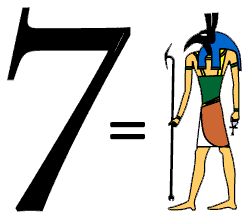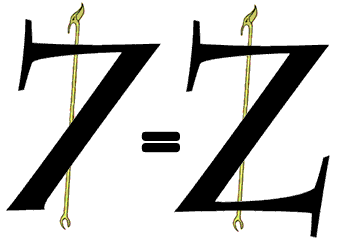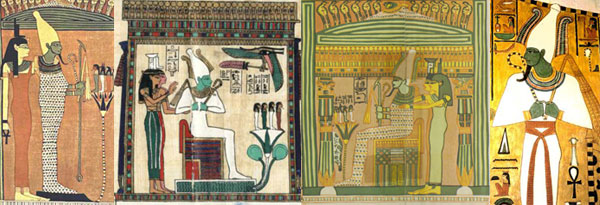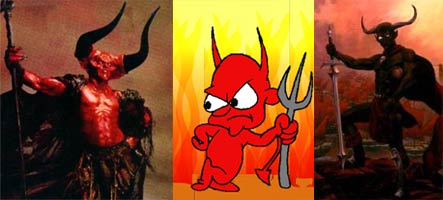
 The number 7 represents the god Set or Seth.
The number 7 represents the god Set or Seth.

The number 7 and the alphabetic letter Z are both derived from the same icon. They're both pictures of the uas or was, Seth Scepter.

According to legend, Assur was the "inventor" of agriculture and animal husbandry. He was also Father God of the Pagans. In the classical Judgment Scene from all periods, Assur is always depicted holding a shepherd's crook and a grain flail. The crook and flail identify Assur as the Father God of farmers and herders. Sometimes in the Judgment Scene, Assur is depicted holding the Seth Scepter along with his crook and flail. The functions of the crook and flail are obvious. They're farm tools. The function of the Seth Scepter is not so obvious.
Whatever the function of the Seth Scepter was or was not, in Assur's hands it was surely a symbol of power. Considering the aura of mystery and uniqueness that Number 7 has always had amongst the numbers, the Seth Scepter was probably an object of magical or mystical powers. Perhaps there was a cult or guild of magicians and mystics devoted to the god Seth. Our modern concepts of Voodoo and "Black Magic" might best convey the powers that the Seth Scepter symbolized. All things considered, the Seth Scepter in Assur's hand was probably the original "magic wand." It represented magical powers of some kind.
Addendum #1
The number 7 has always had some special meaning of evil or bad luck related to it. Being the "seventh son of a seventh son" is still considered to be especially ominous in some cultures, and calling someone a "seventh son of a seventh son" is still used as a curse. The aura of bad luck or evil surrounding the number 7 has ancient origins that spring from the legend of Assur and Isis. Egyptian religion, Egyptian culture, Egyptian civilization, began with the resurrection of Assur. However, Assur didn't die a natural death, he was murdered.
Seth was the Egyptian god of evil. According to the foundation legend of Egypt, Seth and a company of conspirators murdered Assur. They hacked his body into pieces and scattered his severed parts. Isis gathered together Assur's scattered parts and resurrected him from the dead. Isis conceived their son, Heru, from her union with her resurrected king. Afterward she had to ever wary of "fiends of Seth" who were trying to murder her son. Despite his part in Assur's death and his enmity toward Isis, Seth seems to have had a mixed career in Egyptian religion and politics.
Seth's place in Egyptian religion and politics is difficult to understand. It appears that no one has ever made a linear study of the god. The record is confused and confusing. In the early dynasties Seth was a member of a respected company of gods. Perhaps there was a cult of mystics or guild of magicians devoted to the god Seth. In later dynasties, he sometimes appears as the god of evil. Sometimes he appears as a brother of Heru. By the end of the dynastic period, Seth was the personification of evil.
Dynastic Egypt, as we know it, began with the military unification of two warring kingdoms, "Upper Egypt" and "Lower Egypt." Seth was an ancestral deity of the Upper Egypt southern kingdom "Blackland." Our word south is probably derived from the name of Seth. There was surely political tension between the former warring kingdoms of Upper and Lower Egypt long after their "unification." Power struggles amongst political factions and old enemies could account for some of Seth's changing fortunes in Egyptian religion and politics.
The annual flooding of the Nile and wet soils in the Nile Delta render the Delta region unsuitable for the preservation of history. Heavy stone monuments sink into the mud. Wooden structures are washed away. Mud brick monuments dissolve. Durable artifacts get buried under silt. Papyrus records decay. Corpses rot. As a consequence, our knowledge of Egyptian history is based heavily on records from the southern half of the kingdom.
Dynasty XV, the Hyksos' "foreign kings" Dynasty (1663-1555 BC), worshipped Seth and the Semitic war god Reshep. A civil war or a revolution against the Hyksos lasted for generations. During that period, there were different kingdoms contending with the Hyksos and vying for power amongst themselves. Ahmose, a Theban prince, finally succeeded at driving the Hyksos out of Egypt. Following the overthrow of Dynasty XV and expulsion of the Hyksos from Egypt, Seth's fortunes fell.
Ahmose I founded the fabulous Dynasty XVIII. The gods Amun and Thoth gained prominence in Dynasty XVIII. One of the "kings" of Dynasty XVIII was Queen Hatchepsut. Akenaten, the "heretic king" introduced the worship of the sun disk, Aten. When Akenaten died, his heir, Tutankhaten changed his name to Tutankhamen and reintroduced the worship of Amun. Tutankhamen was probably murdered. He left no heir. His successor and possible murderer left no heir. Dynasty XVIII ended with a cousin of Tutankhamen, Horemheb, who also left no heir. So, who would be king? Ramses I, the son of a non-royal general named Seti, "follower of Seth," rose to power. Ramses established Dynasty XIX.
Dynasty XIX resumed the worship of Seth. During the reigns of the Ramses kings of Dynasty XIX, Seth was apparently back in good standing in Egyptian politics and religion. Ramses II of Dynasty XIX reigned for sixty-seven (67) years (1279-1212 BC). Ramses II had 52 sons. Following his long reign, the kingdom went into a long decline. There were economic depressions, internal power struggles, and foreign invasions. Dynasty XIX ended with foreign conquest and domination.

Apparently Seth's fortunes fell with the fall of the empire. Seth, the Egyptian god of evil, is the prototype of Satan in Christianity. Seth is a "fallen angel," so to speak, in Egyptian religion as Satan is in Christian religion. In the end, Seth with his scepter is the prototype of our familiar concept of the Devil.
(See the Alphabet
Z page on this website for a further discussion of Set or Seth.)
Resurrect Isis. Dark forces of Seth have kept her down long enough. Let the Mother Goddess awaken us to a new age of enlightenment.
|
Reader responses are invited. |
Return to Home Page . . . Return to Table of Contents Hub
Links to number pages:
Number 6 Page . . . Number 8 Page . . .
Links to related alphabet pages
Alphabet Z page . . .